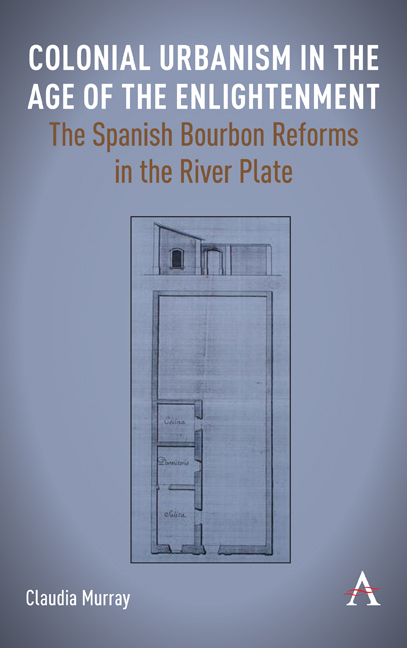Book contents
- Frontmatter
- Contents
- List of Figures and Tables
- Acknowledgements
- Introduction
- 1 The Spanish Empire Before the Bourbon Reforms
- 2 The River Plate Before 1776 and the Bourbon Reforms
- 3 Urban Expansion
- 4 The Image of Power
- 5 Ceremonies of Power
- 6 Disciplining Porteños’ Private Architecture
- 7 The British Assault on the River Plate
- Appendix 1
- Bibliography
- Index
6 - Disciplining Porteños’ Private Architecture
Published online by Cambridge University Press: 28 February 2024
- Frontmatter
- Contents
- List of Figures and Tables
- Acknowledgements
- Introduction
- 1 The Spanish Empire Before the Bourbon Reforms
- 2 The River Plate Before 1776 and the Bourbon Reforms
- 3 Urban Expansion
- 4 The Image of Power
- 5 Ceremonies of Power
- 6 Disciplining Porteños’ Private Architecture
- 7 The British Assault on the River Plate
- Appendix 1
- Bibliography
- Index
Summary
Government Regulations and the Development of Private Buildings
Phillip II's Ordinances of 1573 stipulated that private architecture in colonial cities should be homogeneous and have uniformity. This principle was still debated during the eighteenth century when theorists at the time discussed the lack of uniformity in cities. A prominent architectural theorist expressed in 1753 that towns in France were ‘a mass of houses crowded together haphazardly and without system, planning or design’. While in Spain, another recognised authority, Abbot Antonio Ponz Piquer (1725–1792), published a book titled Travels in Spain (1772), where he critically revised peninsular architecture while advocating for ordered and homogeneous cities. Similar arguments were circulating in the colonies. According to Manila's governor, the street line in this city in 1792 was a collection of different houses including elegant buildings and poorly built ‘cabins and huts’. The governor was appalled by these conditions, adding that these huts were built on an irregular plan that damaged the geometrical layout of the city. Without a doubt, in Europe and the Spanish American colonies, the ideal cities of the Enlightenment were ordered, with unbroken street lines and with houses following a similar style and quality. What theorist wanted and admired was regularity, and while European cities struggled with their medieval layouts and crumbling housing stock, the colonies in the New World had the advantage of been developed following the gridiron system, which provided a solid platform for ordered geometry.
In Buenos Aires, the introduction of planning permissions for private buildings was consistent with the ideas of Abbot Antonio Ponz, who declared that no government should allow complete freedom to people for building their dwellings. The reason for this statement was that, according to him, no citizen had the right to ‘make the city look ugly’ emphasising that governments should control both planning permissions and architectural styles. Such system of planning permissions appears thus as the ultimate tool in government control of the urban space and personal choice. Equally and in the context of the enlightenment, ideas like the ‘benefit for all’ had to prevail over individuality. Therefore, all citizens had to regularise their façades in order to display in the whole, a magnificent city, characterised by unity and order, showing harmony and support for the monarchy, thus sending in turn a strong message of power to all rival nations.
- Type
- Chapter
- Information
- Colonial Urbanism in the Age of the EnlightenmentThe Spanish Bourbon Reforms in the River Plate, pp. 165 - 198Publisher: Anthem PressPrint publication year: 2023



